 |
Focus features two in-depth reviews each month of fine art, architecture and design exhibitions and events at art museums, galleries and alternative spaces around Japan. The contributors are non-Japanese art critics living in Japan. |
|
|
 |
 |
 |
Art Censorship: Whose Problem Is This?
Lucy Birmingham |
 |
Makoto Aida at MOT, carving a woodblock to print a series of cards for an Iroha Karuta game. |
Art and politics can make strange bedfellows at either public or private art institutions. The test for both is allowing artists' work to speak to controversial issues, regardless of funding sources. Two important exhibitions in Tokyo are currently spotlighting politically sensitive issues -- education and war -- and in the process are testing the reputation of the respective museums.
The Museum of Contemporary Art Tokyo (MOT), overseen by the Tokyo Metropolitan Government, typically shies away from politically controversial shows. But their annual summer exhibition for kids has unwittingly turned out to be just such a platform.
An Art Exhibition for Children -- Whose Place Is This? includes installations by four artists and artist groups: Jurgen Lehl, Kenjiro Okazaki, Alfredo & Isabel Aquilizan, and the Aida Family.
 |
|
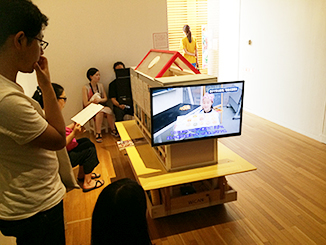 |
|
|
|
The Aida Family exhibit Who Does Society Belong To?, showing the work Manifesto, 2015, Chinese ink on cloth. |
|
Hiroko Okada X WICAM, Education X Art = ? ~NIPPON Education TV~, 2014, video installation. |
The standout, by far, is the installation by Makoto Aida, his wife Hiroko Okada, and junior high school son Torajiro. Their exhibit Who Does Society Belong To? is an entertaining hodgepodge of works reflecting the three family members' opinions about Japanese politics and society. Though arranged with the cluttered feel of many family homes, it now sits in the eye of a political storm.
MOT curators and Tokyo government officials called two of the pieces inappropriate for children and asked for changes. Aida wrote in his Tumblr blog that they demanded he remove the two works. One is a six-meter scroll of white fabric titled Manifesto with written complaints directed at the Education Ministry. The other is a satirical video of Aida as Prime Minister Shinzo Abe, titled A Video Recording of a Man Calling Himself Japan's Prime Minister, Making a Speech at an International Assembly.
Go figure. Aida is celebrated for lampooning government authority and social norms. Even his disturbing obsession with pretty young girls pokes fun at the Japanese disturbing obsession with the same. He made his mark in the 1990s with a mangaesque painting of a girl being raped and killed by a three-headed dragon. His 1996 six-panel folding screen of Japanese fighter planes attacking New York City was considered politically inappropriate but eerily prophetic of the city's 9/11 disaster.
 |
|
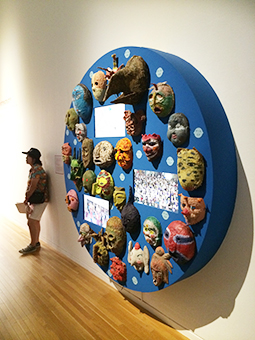 |
|
|
|
Makoto Aida, A Video Recording of a Man Calling Himself Japan's Prime Minister, Making a Speech at an International Assembly, 2014, single-channel video, 20 copies of script. |
|
Team KAO (Mitsuo Yamamoto, Hideki Tanaka, Torajiro Aida, Hiroko Okada) in cooperation with volunteers from Kaminoge School at Tama Art University and Makoto Aida, The Faces in the World, 2015, mixed media. |
Called perverted, insane, and a "bad boy" artist, Aida is also considered one of Japan's strongest and most courageous conceptual artists today, unafraid to make statements against social and political injustice. In Japan's present climate of historical revisionism and censorship, Aida is the nail that sticks up. As such, he certainly gets people thinking. For children, this is supposed to be a good thing.
Aida is surprised at the uproar. "I felt the children's summer exhibitions showing [at MOT] every year were too boring. The usual things for kids," he explains. "The curator asked me to create something more challenging, so I think I've answered to that. Referring to the "Manifesto" work, he adds: "Most families talk at home about education. My wife and son have complained to his school, so the work is a kind of example of my family's complaint. It has created quite a commotion, but it's not a radical thing . . . I am not anti-government."
Ironically, the description of the exhibition on the MOT website states that it "can be said to represent intersections between 'society' and 'self' . . . you'll find yourself confronted with the various problems we need to consider in order to live in the future such as the global environment, education, freedom, etc."
 |
|
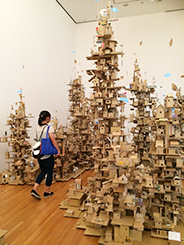 |
|
|
|
Jurgen Lehl (1944-2014), Who Does Earth Belong To?, installation with lamps using plastic waste found on beaches in Okinawa. |
|
Alfredo & Isabel Aquilizan, Where Is My Place?, installation with miniature cardboard condominiums supported by steel scaffolding. |
Aida, it seems, is not backing down. As of late August, the museum had not forced him to alter the work. Ultimately, a standstill could be the best move, a way to preserve the museum's reputation for fairness. But the official response could be a sign of stricter oversight to come.
What is the source of the pressure? "Self-censorship," says Mori Art Museum (MAM) curator Natsumi Araki. "I heard it's from within [MOT], which is not a good thing, but understandable. Self-censorship is a big issue in Japan, more problematic than censorship imposed from outside."
MAM is an anomaly in Japan, where most contemporary art museums are publically owned. The museum has faced protests (Makoto Aida's 2013 exhibition there was one such target), but its status as a private institution backed by the powerful Mori family makes government censorship highly unlikely. The lack of self-censorship can be credited in large part to the museum's chairperson, Yoshiko Mori, who gives curators wide room to maneuver.
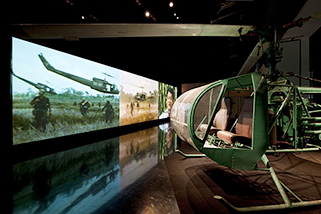 |
|
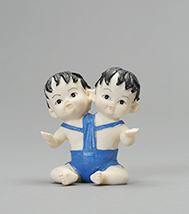 |
|
|
|
Dinh Q. Lê, The Farmers and the Helicopters, 2006, 3-channel color video with sound, 15 min.; handcrafted full-size helicopter, 250 x 1,070 x 350 cm. Collaborating artists: Tran Quoc Hai, Le Van Danh, Phu-Nam Thuc Ha, Tuan Andrew Nguyen. Commissioned by Queensland Gallery of Modern Art, Australia. Installation view from "Reflection: The World Through Art," Dojima River Biennale 2009, Osaka. Photo by Kazuo Fukunaga, courtesy of Mori Art Museum, Tokyo |
|
Dinh Q. Lê, Damaged Gene (detail), 1998, single-channel color video with sound, knitted baby clothing, stuffed animals, resin and plastic figurines, pacifiers, 16 min. 58 sec. Commissioned by The Gunk Foundation, New York. Photo by Keizo Kioku, courtesy of Mori Art Museum, Tokyo |
This includes their current exhibition. Curated by Araki, it is the first solo show by the celebrated Vietnamese artist Dinh Q. Lê. In Vietnam his work is highly censored because of political content related to the Vietnam War. "It's a part of contemporary art to raise discussions and questions," explains Araki. "Otherwise, we are just ignored. It's not good. So I really hope there will be more discussion about his work."
Titled Dinh Q. Lê: Memory for Tomorrow, the show is indeed something to talk about. "As a curator I've learned so much from Dinh's work . . . and I'm personally encouraged by his courage to face his past and the very controversial issues regarding the Vietnam War," says Araki. "He's not afraid to criticize what America did [to the country]."
The timing is right. This year is the 40th anniversary of the end of the Vietnam War and the 70th anniversary of the end of World War II.
"After seeing Dinh's work and criticism and analysis, I would really like Japan to face its past, and the contemporary political issues now happening in this country," says Araki. "Memory" in the title signifies more than the past, she adds. "We want [to encourage viewers] to face the past and pick up individual memories in order to live for a more hopeful and peaceful future."
All photos by Lucy Birmingham except where otherwise indicated;
all images appear by permission of the Museum of Contemporary Art Tokyo and Mori Art Museum.
|
 |
 |
Lucy Birmingham
Lucy Birmingham is a long-time, Tokyo-based journalist, scriptwriter, author, and former photojournalist. Until recently she served as president of the Foreign Correspondents' Club of Japan. Her articles have appeared in many publications, including TIME magazine, the Wall Street Journal, Newsweek, Bloomberg News, and Architectural Digest. As an arts and culture writer her articles have appeared in publications including Artinfo.com, Artforum.com, and ARTnews. She is also a scriptwriter and narrator for NHK (Japan's public broadcaster) and has published several books including Strong in the Rain: Surviving Japan's Earthquake, Tsunami, and Fukushima Nuclear Disaster.
lucybirmingham.com |
|
 |
|